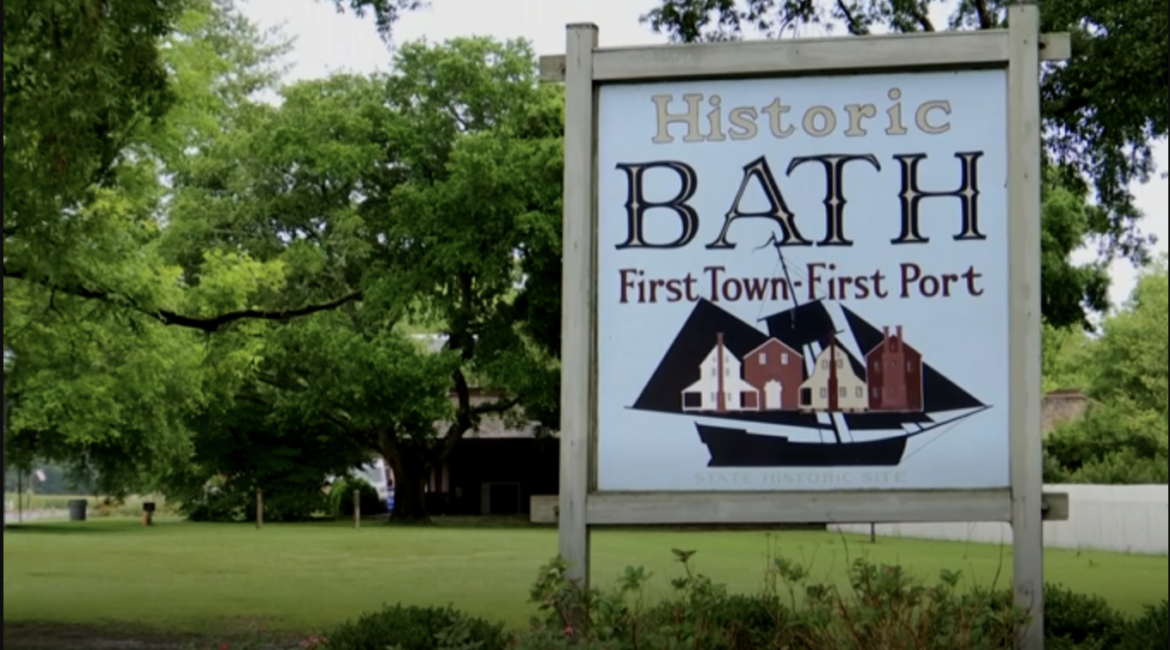

Historic Bath Walking Tour
When visiting Historic Bath you will surely stop by to admire the two stately homes that anchor Main St. The Palmer-Marsh House which is located on the east side of South Main St. and Joseph Bonner House which is located at the end of Main St. overlooking picturesque Bonner Point. In addition to these grand homes, there are other historic houses which served as residences for influential individuals. Get a sense of Bath’s history by picking up a Bath walking tour map and you’ll soon realize there’s more to Bath than just pirates.
Historic Bath Walking Tour Guide
Pick up your walking guide at the Historic Bath – NC Historics Sites located in the old Bath High School at the corner of Harding and Carteret Sts. Included in the guide are historic homes, churches, specific event locations and the site of the old jail. As you are following the guide make sure to watch out for the North Carolina Highway Historical Markers on Main Street and Craven Street as well.
Historic Bath
Bath played a significant role in shaping the early history of North Carolina. Incorporated as the first town in 1705, Bath was founded as a result of European settlement near the Pamlico River in the 1690s. A total of 50 people lived in Bath by 1708, and there were 12 houses in the town. With its location on the Pamlico and close proximity to the Atlantic ocean Bath became the first port and developed a trade in naval stores,furs and tobacco. Political rivalries, Indian wars, and piracy marked its early years but in 1746 Bath was considered for the colony’s capital. In the late 1700s, Bath lost most of its importance and trade when the county government moved away. Today, Bath’s original town limits which border Bath Creek encompass the historic district.
Buildings / Markers on the Walking Tour:
- Palmer-Marsh House – This is one of NorthCarolina’s most notable 18th century homes and is a National Historic Landmark. Built ca. 1751 for Michael Cotanch. Named after Robert Palmer who acquired it in 1764. By the time of its construction, the town had a courthouse, a brick church and several taverns. The house was considered large in its day, befitting Coutanche’s status as a merchant, regional justice, and colonial assemblyman. The two-and-a-half-story building measures 25 feet wide by 51 feet long, with the shorter, gable end of the house facing the street. The building’s most impressive feature is at the rear: a monumental double chimney.
- Glebe House – Built ca.1830. The house was owned by Dr.John F Tompkins in the mid-1800s. Tompkins was an agriculturalist and founder of the North Carolina State Fair.The Glebe House is very similar to the Bonner House, so similar that it has been said the two houses were possibly built by the same person.
- Carrow House – Historically, Bath was dotted with small one-story houses like the Carrow House. This style was typical of fishermen and their families in the late 19th century.
- Dr. T.J. Nicholson House – Built ca. 1890. Dr. Nicolson had a great deal of respect among Bath residents. According to reports, he performed the first Cesarean section in NC in 1893, saving both mother and child.
- W.W. Mason House – This large Victorian two story house was built for W.W. Mason, a fisherman and fish market proprietor in Bath. He owned the first motorboat in Bath.
- Archbell -Sayer House -Typical of the type of residential architecture found throughout eastern North Carolina, this two-story frame house has a one-story front porch. Former home of hard-working farmer Jamie Archbell, who owned several farms near Bath.
- St Thomas Episcopal Church – Established in 1734, this is the oldest church building in the state.
- John Lawson Historic Marker – John Lawson (1674-1711) was one of Bath’s first residents and a surveyor who wrote the first history book on the Carolina colony in 1709.Lawson was killed by Tuscarora Indians while exploring the Neuse River in 1711. His home was located where the Bonner House sits.
- Joseph Bonner House – Joseph Bonner purchased this property in 1830 and likely erected his home in late summer and fall of that year. Bonner family members claim that there is a ghostly phenomenon called “Blackbeard’s” lights. During violent storms, they would see a ball of fire as large as a man’s head sail back and forth at the mouth of Bath Creek.
A walking tour of historic Bath, North Carolina, is a delightful journey through time and a testament to the enduring charm of this quaint town. From its maritime legacy to its connection with Blackbeard, and its well-preserved architecture, Bath invites visitors to explore its rich history at every turn. Consider staying at The Inn on Bath Creek if you would like to spend more than just a day. Built in the early-1990s, it features all the charms and details of an old house. With cozy rooms and a homemade 5 course breakfast it is a perfect getaway.
0 Comments